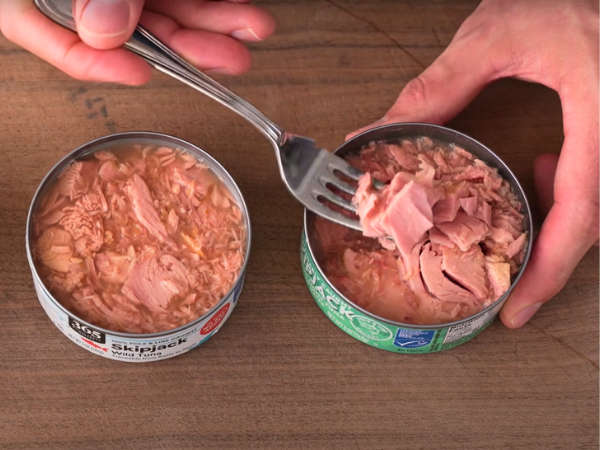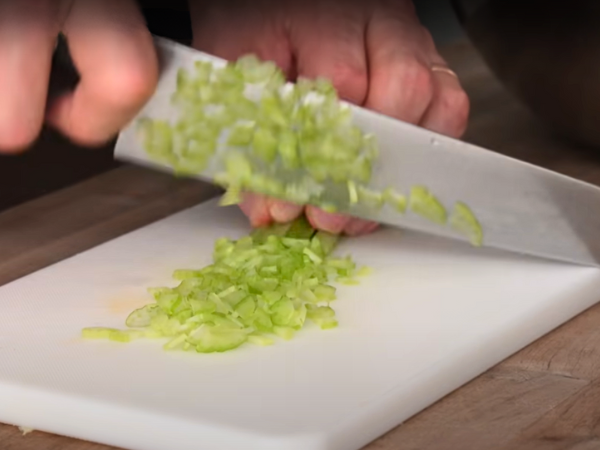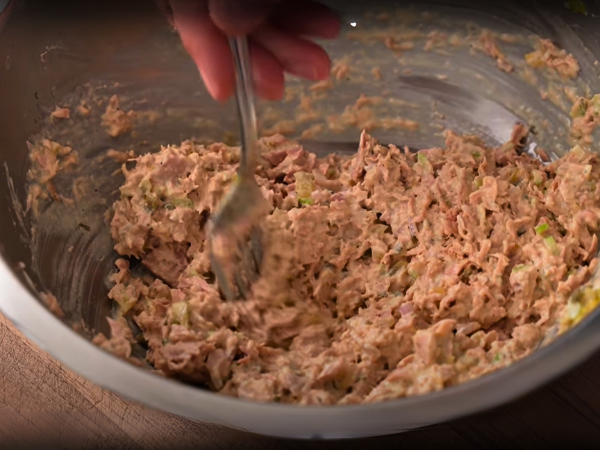Japanese Tuna Salad Sandwiches offer a delightful twist on the classic tuna sandwich. This version incorporates traditional Japanese flavors, making each bite a unique experience.
Fresh vegetables add crunch and balance to the sandwich. This recipe is quick and easy, perfect for lunch or a light dinner. It’s a fantastic way to enjoy familiar ingredients in an exciting, new manner.
Table of Contents
| Preparation Time | Cooking Time | Rest Time | Servings |
|---|---|---|---|
| 10-15 minutes | None | None | 2 |
Ingredients for 2 Japanese Tuna Salad Sandwich
To create the perfect sandwich, you need to gather the right ingredients. Let’s explore the key components needed for this delicious dish.
Tuna Selection
The star of this sandwich is the tuna. Choosing the right tuna is crucial for the best flavor and texture. Here are some options:
- Canned Tuna: 1 can (about 5 oz) of high-quality tuna in water, drained.
- Fresh Tuna: 4 oz of sashimi-grade tuna, finely diced (optional if using fresh instead of canned).
- Oil-Packed Tuna: 1 can (about 5 oz) of tuna in oil, drained (optional if substituting for canned tuna).
For a quick comparison:
| Type of Tuna | Pros | Cons |
|---|---|---|
| Canned Tuna | Convenient, Long Shelf Life | May Contain Additives |
| Fresh Tuna | Fresh Flavor, Tender Texture | Requires Preparation |
| Oil-Packed Tuna | Rich Flavor | Higher Caloric Content |
Choose the type that suits your taste and convenience. Remember, the quality of tuna will greatly impact the overall dish.
Vegetables
Vegetables add crunch and freshness to your sandwich. Selecting the right vegetables balances the flavors and enhances the overall texture. Here are some must-have veggies:
- Cucumber: 1/4 of a medium cucumber, thinly sliced.
- Carrots: 1 small carrot, finely grated.
- Red Onion: 1/4 of a small red onion, thinly sliced.
- Lettuce: 2-4 leaves of Romaine or Iceberg lettuce.
Consider these additional options for variety:
- Avocado: 1/2 of a medium avocado, sliced.
- Radish: 2-3 radishes, thinly sliced.
- Bell Peppers: 1/4 of a medium bell pepper, thinly sliced.
Mix and match these veggies to suit your preference. Fresh vegetables make the sandwich more nutritious and tasty.
Condiments
Condiments are the flavor enhancers of your sandwich. Choosing the right condiments can make a big difference. Here are some essential options:
- Japanese Mayonnaise: 2-3 tablespoons (adjust to taste).
- Soy Sauce: 1/2 teaspoon.
- Rice Vinegar: 1 teaspoon.
- Wasabi: 1/4 teaspoon (or to taste).
For additional flavor, consider these options:
- Sesame Oil: 1/4 teaspoon.
- Pickled Ginger: 1-2 teaspoons, finely chopped.
- Furikake: 1/2 teaspoon for seasoning.
Combine these condiments to create a balanced and flavorful spread. They elevate the sandwich to a whole new level.
Assembly
Bread: 4 slices of your preferred bread (white, whole grain, or Japanese milk bread).

Step 1: Prepare the Ingredients
Drain the Tuna:
- If using canned tuna (in water or oil), drain it thoroughly using a fine-mesh sieve or by pressing gently with a spoon to remove excess liquid.
Dice the Fresh Tuna (if using):
- If you’re using fresh, sashimi-grade tuna, finely dice about 4 oz of the tuna and set it aside.
Prepare the Vegetables:
- Cucumber: Thinly slice 1/4 of a medium cucumber.
- Carrots: Finely grate 1 small carrot.
- Red Onion: Thinly slice 1/4 of a small red onion.
- Lettuce: Wash and pat dry 2-4 leaves of Romaine or Iceberg lettuce.
Optional Vegetables:
- Avocado: Slice 1/2 of a medium avocado.
- Radish: Thinly slice 2-3 radishes.
- Bell Peppers: Thinly slice 1/4 of a medium bell pepper.


Step 2: Prepare the Tuna Salad
Combine Tuna and Condiments:
- In a mixing bowl, add the drained canned tuna (or diced fresh tuna if using).
- Add 2-3 tablespoons of Japanese mayonnaise (like Kewpie), 1/2 teaspoon of soy sauce, 1 teaspoon of rice vinegar, and 1/4 teaspoon of wasabi (or to taste).
- Mix well until all ingredients are evenly combined.
Optional Flavor Enhancers:
- If desired, add 1/4 teaspoon of sesame oil for a nutty flavor.
- Finely chop 1-2 teaspoons of pickled ginger and mix it into the tuna salad.


Step 3: Assemble the Sandwich
Lay Out the Bread:
- Place 4 slices of your preferred bread (white, whole grain, or Japanese milk bread) on a clean surface or cutting board.
Layer the Ingredients:
- On the first slice of bread, place 1-2 leaves of lettuce to create a base.
- Spread a generous portion of the tuna salad mixture over the lettuce.
- Layer with your prepared vegetables: cucumber slices, grated carrot, and red onion slices.
- Add any optional vegetables like avocado slices, radish slices, or bell peppers.
Sprinkle with Furikake (optional):
- If you like, sprinkle 1/2 teaspoon of furikake over the top of the assembled vegetables for added flavor and texture.
Top the Sandwich:
- Place the second slice of bread on top to complete the sandwich.
- Press down gently to help hold the sandwich together.


Step 4: Serve
Slice the Sandwich:
- For a more traditional presentation, cut the sandwich diagonally into halves or quarters.
Serve:
- Serve immediately with your choice of side, such as chips, pickles, or a small salad.
Flavor Enhancements
The secret lies in the flavor enhancements that elevate this simple dish to a gourmet experience. By adding the right spices, herbs, citrus zest, and umami boosters, you can transform your tuna salad into a culinary masterpiece.
Spices And Herbs
Spices and herbs bring a burst of flavor to your Japanese Tuna Salad Sandwich. They add depth and complexity, making each bite memorable. Here are some key spices and herbs to include:
- Wasabi Powder: Adds a spicy kick that pairs well with tuna.
- Shiso Leaves: Offers a unique, minty flavor that enhances the freshness of the salad.
- Ginger: Adds warmth and a slight zing.
- Green Onions: Provides a subtle onion flavor without overpowering the dish.
For the best results, finely chop the herbs and mix them thoroughly with the tuna. You can also use a mortar and pestle to grind the spices for a more intense flavor. Here’s a simple table to guide you:
| Spice/Herb | Quantity |
|---|---|
| Wasabi Powder | 1 tsp |
| Shiso Leaves | 5 leaves, chopped |
| Ginger | 1 tsp, grated |
| Green Onions | 2 stalks, chopped |
Citrus Zest
Citrus zest brightens up the flavors of your Japanese Tuna Salad Sandwich. It adds a fresh, tangy note that complements the rich taste of tuna. Here are some citrus options to consider:
- Lemon Zest: Adds a fresh and tangy flavor.
- Yuzu Zest: Provides a unique, slightly sweet citrus note.
- Lime Zest: Offers a sharp, zesty kick.
Use a fine grater to zest the citrus fruit, ensuring you only get the outer peel. The white pith underneath can be bitter. Mix the zest directly into the tuna salad for best results. Here’s a simple guideline:
| Citrus | Quantity |
|---|---|
| Lemon Zest | 1 tsp |
| Yuzu Zest | 1 tsp |
| Lime Zest | 1 tsp |
Combining different citrus zests can create a more complex and layered flavor profile. Experiment to find your perfect blend.
Umami Boosters
Umami, the fifth taste, adds depth and richness to your Japanese Tuna Salad Sandwich. These ingredients can help you achieve that savory, satisfying flavor:
- Soy Sauce: Adds a salty, umami-rich flavor.
- Miso Paste: Provides a deep, savory taste.
- Seaweed: Offers a briny, oceanic flavor.
- Fish Sauce: Intensifies the umami notes.
To incorporate these umami boosters, mix small amounts into the tuna salad. Here’s a table for guidance:
| Umami Booster | Quantity |
|---|---|
| Soy Sauce | 1 tbsp |
| Miso Paste | 1 tbsp |
| Seaweed | 1 tbsp, finely chopped |
| Fish Sauce | 1 tsp |
Balancing these umami boosters with the other flavor enhancements ensures a well-rounded and delicious tuna salad.
Choosing Bread
A key element is the bread. Choosing the right bread can elevate your sandwich to a gourmet experience.
Types Of Bread
The bread you select impacts the overall flavor and texture of your sandwich. Here are some popular choices:
- White Bread: Soft and fluffy, it complements the rich flavors of the tuna salad without overpowering them.
- Whole Wheat Bread: Adds a nutty flavor and extra fiber, making your sandwich healthier.
- Sourdough: Offers a tangy taste and a chewy texture, perfect for adding a unique twist.
- Brioche: Slightly sweet and buttery, it adds a touch of luxury to your sandwich.
- Ciabatta: With its airy structure and crispy crust, it holds up well to moist fillings.
Here’s a table to compare these bread types:
| Bread Type | Flavor | Texture |
|---|---|---|
| White Bread | Mild | Soft |
| Whole Wheat Bread | Nutty | Dense |
| Sourdough | Tangy | Chewy |
| Brioche | Sweet | Soft |
| Ciabatta | Mild | Crunchy |
Texture Considerations
The texture of your bread plays a crucial role in the sandwich experience. Consider the following aspects:
- Softness: Soft bread like white or brioche is easy to chew and doesn’t overshadow the tuna salad.
- Density: Dense bread like whole wheat offers a hearty bite and holds the fillings well.
- Chewiness: Chewy bread like sourdough adds a satisfying texture that contrasts with the creamy tuna.
- Crispiness: Crispy bread like ciabatta provides a delightful crunch that enhances the overall bite.
Consider the balance between the softness of the tuna salad and the texture of the bread. A creamy filling pairs well with a chewy or crispy bread. A soft bread can make for a more uniform, gentle bite.
Toasting Options
Toasting your bread can significantly enhance your sandwich. Here are some toasting options:
- Light Toast: Provides a slight crunch while keeping the bread mostly soft. Ideal for delicate bread like brioche.
- Medium Toast: Adds a balanced crunch that works well with both soft and dense bread.
- Heavy Toast: Creates a robust crunch, perfect for chewy or dense bread types like sourdough and ciabatta.
Toasting can also add a warm, comforting element to your sandwich. Lightly toasted bread can bring out the natural flavors of the bread and fillings. A medium toast offers a perfect middle ground with a satisfying crunch. Heavy toasting can create a strong contrast between the crispy exterior and the creamy tuna salad.
Consider using a toaster oven or a grill pan for toasting. Experiment with different toasting levels to find your perfect match. Remember, the goal is to complement the creamy texture of the tuna salad with the right amount of crunch.
Nutritional Information Japanese Tuna Salad Sandwich
Understanding the nutritional information of the Japanese Tuna Salad Sandwich helps you make informed dietary choices and enjoy this delightful meal guilt-free.
Approximate Calorie
Calculating the calories in a Japanese Tuna Salad Sandwich depends on the ingredients used. On average, a sandwich contains around 300-400 calories. Here’s a breakdown of the primary components:
- Bread: Two slices of whole wheat bread typically contain around 140-160 calories.
- Tuna: One can of tuna (in water) usually has about 100-120 calories.
- Mayonnaise: One tablespoon of mayonnaise adds approximately 90 calories.
- Vegetables: Adding veggies like lettuce, cucumber, and carrots can add around 10-20 calories.
Combining these ingredients, the total calorie count for one sandwich lands between 300 and 400 calories, making it a balanced meal option.
Nutritional Breakdown
Understanding the nutritional breakdown of a Japanese Tuna Salad Sandwich provides insights into its health benefits. Here’s a detailed look at the nutrients:
| Nutrient | Amount per Serving |
|---|---|
| Calories | 300-400 kcal |
| Protein | 20-25 grams |
| Fat | 12-15 grams |
| Carbohydrates | 25-30 grams |
| Fiber | 3-5 grams |
| Sodium | 500-600 mg |
The sandwich is rich in protein due to the tuna, providing 20-25 grams per serving. This helps in muscle repair and growth. The fat content, mainly from mayonnaise, ranges between 12-15 grams, offering essential fatty acids. The whole wheat bread contributes 25-30 grams of carbohydrates, supplying energy.
Additionally, the sandwich includes 3-5 grams of fiber from the vegetables and bread, aiding digestion. The sodium content, primarily from tuna and mayonnaise, is around 500-600 mg, so it’s advisable to monitor salt intake if you have dietary restrictions.



